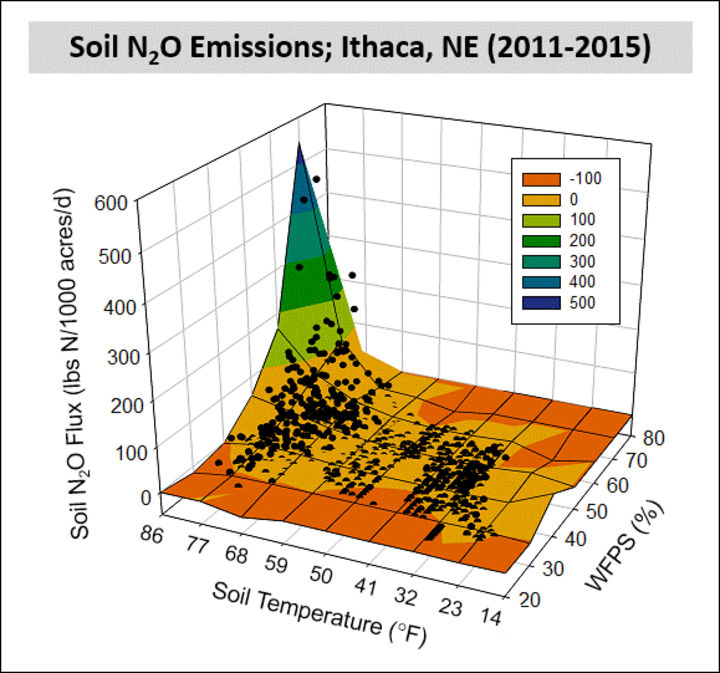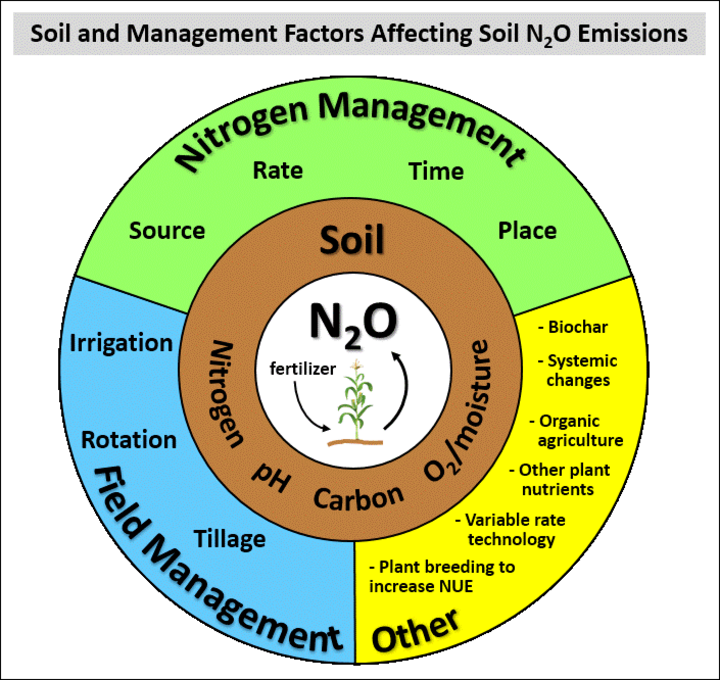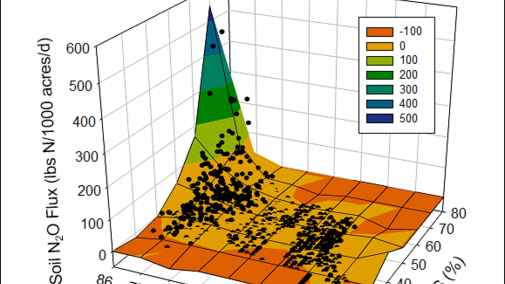Virginia L. Jin, Research Soil Scientist, USDA-Agricultural Research Service, Agroecosystem Management Research Unit, Lincoln
Bijesh Maharjan, Extension Soil and Nutrient Management Specialist
Leonardo M. Bastos, PhD Candidate in Soil Fertility/Precision Agriculture, Department of Agronomy and Horticulture, University of Nebraska-Lincoln
Maximizing the opportunity for crops to take up fertilizer nitrogen can boost yields while decreasing the loss of N to the environment. When N fertilizer is emitted into the air from the soil surface as nitrous oxide (N2O) gas, otherwise known as laughing gas, it is called a direct N2O emission. Nitrous oxide is a major ozone depleter as well as a potent greenhouse gas with 300 times the global warming potential of carbon dioxide on a per ton basis. Indirect N2O losses occur when N is lost via
- nitrate leaching,
- ammonia volatilization, or
- emissions of other N gases such as ammonia with some transformed into N2O.
Although indirect losses are much higher than direct N2O emissions, similar fertilizer management strategies can be used to minimize both types of loss and increase the availability of fertilizer N for crop growth.
Why does direct N2O emission occur?
The major cause of direct N2O emission from agricultural fields is soil microbial activity, primarily through the processes of nitrification (which occurs in well-aerated soils) and denitrification (which occurs in saturated soils). Because these loss pathways are biological, soil N2O emissions are driven by temperature and soil water conditions. In a long-term field study in eastern Nebraska, soil N2O emission from an irrigated continuous corn site was highest when the soil was warm (> 21 °C, or >70 °F) and relatively wet (water-filled pore space more than 60%) (Jin et al., 2017) (Figure 1).
Direct N2O emissions will occur regardless of whether fertilizer is applied because the decomposition of soil organic matter also leads to the same soil microbial processes that release N2O. The application of fertilizer, however, will significantly increase the amount of direct N2O emission and indirect N losses because of greater N availability.

How can management decrease direct N2O emissions?
The choice of fertilizer management strategy has a major impact on direct N2O emissions. Outcomes of fertility management decisions will vary from field to field, and will depend on other management practices (i.e., tillage, rotation sequence, irrigation, cover crop use), soil type, and local climate (Figure 2). In general, using the 4R nutrient management principles (right source, right rate, right time, right place) will reduce both direct and indirect N2O losses.
More specifically, fertility practices that maximize the opportunity for crops to take up N are expected to reduce N losses overall. Increased N uptake as a percent of total available N can be accomplished by minimizing the length of time between N application and crop N uptake (i.e., by using in-season and split fertilizer applications). The use of stabilized fertilizers, specifically slow- or controlled-release fertilizers, urease inhibitors, and nitrification inhibitors (NIs), can also sustain the availability of fertilizer N to crops for a longer time by delaying nitrification and protecting N from nitrate leaching, denitrification, and ammonia volatilization. Stabilized fertilizers also have been shown to boost yield, in some cases by 3% to 13% (Halvorson et al., 2014; Hatfield and Parkin, 2014; Shapiro et al., 2016).
The effectiveness of stabilized N fertilizers to protect against N losses and increase yield will vary with management, soils, and climate. In Merrick County the use of controlled-release urea significantly reduced indirect N2O emission risks and increased crop yield in a coarse-textured soil, regardless of inter-annual differences in weather (Figure 3) (Maharjan et al., 2016). In extreme weather conditions, NIs failed to improve conventional fertilizer performance, but split application of conventional N fertilizers reduced N losses and improved yield (Maharjan et al., 2017). In other Nebraska studies (Clay, Dixon, Merrick, and Pierce counties), the use of stabilized fertilizers increased grain yield only when N rate approached the optimum fertilizer rate for a given field, or when weather (i.e., excessive rain) promoted N losses through leaching/denitrification (Bastos and Ferguson, unpublished data; Shapiro et al., 2016). Although the use of stabilized N fertilizers does not always lead to higher yield, it can reduce the uncertainty of N availability due to year-to-year variation in weather conditions.
Soil scientists at the University of Nebraska have developed the Nitrogen Loss Assessment Tool (N-LAT, Wortmann et al., 2014). This spreadsheet tool takes into account different user-defined parameters related to N fertilizer management (e.g., N source, rate, timing, placement, use of stabilized fertilizer) and county-level soils and weather data to estimate N losses. Producers can use N-LAT to simulate different scenarios of N management and their impact on N losses in their county. For more information about N-LAT, including a link to download the spreadsheet, see the Nebraska Extension publication, Nitrogen Loss Assessment Tool (N-LAT) for Nebraska: Background and Users Guide


Recommendations
For growers in Nebraska, minimizing fertilizer lost as N2O will depend on fertilizer management decisions, including product choices. These include considerations for:
- selecting N application methods and rates specific to the soil, local climate, and crop N need;
- using controlled release fertilizers or nitrification inhibitors in coarse-textured soil, especially where leaching of nitrate-N is a concern;
- using split application of conventional N, which is as effective as using a controlled-release N product.
References
Decock, C. Mitigating nitrous oxide emissions from corn cropping systems in the Midwestern U.S.: potential and data gaps. 2014. Environmental Science and Technology 48: 4247-4256.
Halvorson, A.D., C.S. Snyder, A.D. Blaylock, S.J. Del Grosso, Enhanced-efficiency nitrogen fertilizers: potential role in nitrous oxide emission mitigation. 2014. Agronomy Journal 16: 715-722.
Hatfield, J.L., T.B. Parkin. Enhanced efficiency fertilizers: effect of agronomic performance of corn in Iowa. 2014. Agronomy Journal 106: 771-780.
Jin, V.L., M.R. Schmer, C.E. Stewart, A.J. Sindelar, G.E. Varvel, B.J. Wienhold. Long-term no-till and stover retention each decrease the global warming potential of irrigated continuous corn. 2016. Global Change Biology 23: 2848-2862.
Maharjan B., R.B. Ferguson, G. Slater. Polymer-coated urea improved corn response compared to UAN when applied on a coarse-textured soil. 2016. Agronomy Journal 108: 509-518.
Maharjan B., R.B. Ferguson, G. Slater. Irrigated corn productivity as influenced by nitrogen source, rate and climatic conditions. 2017. Agronomy Journal, in press.
Shapiro, C., A. Attia, S. Ulloa, M. Mainz. Use of five nitrogen source and placement systems for improved nitrogen management of irrigated corn. 2016. Soil Science Society of America Journal. doi:10.2136/sssaj2015.10.0363
Wortmann, C.S., J.A. Jansen, M.W. Van Liew, R.B. Ferguson, G.W. Hergert, C.A. Shapiro, T.M. Shaver. Nitrogen Loss Assessment Tool (N-LAT) For Nebraska (Nebraska Extension NebGuide). 2014.

